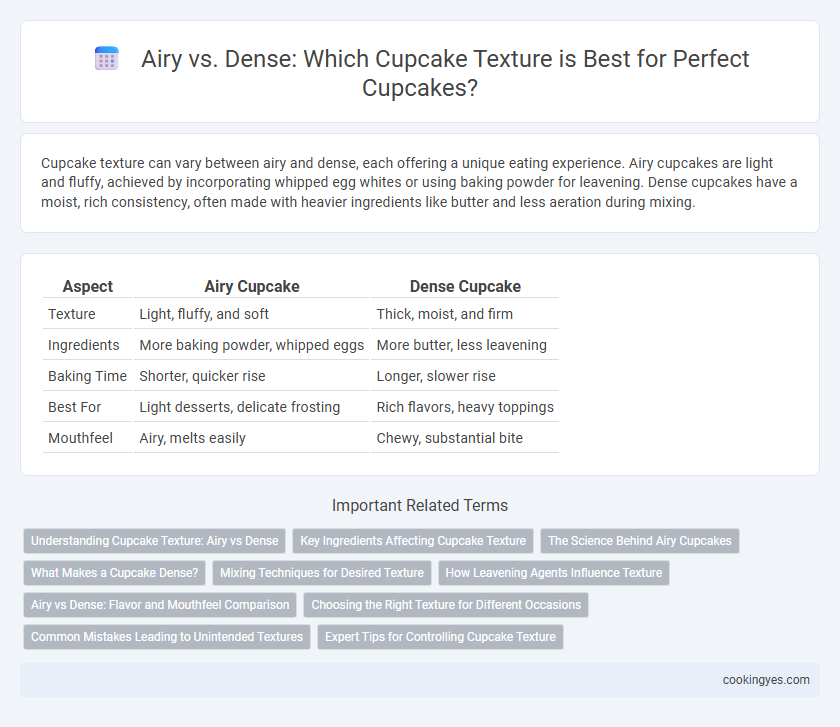Cupcake texture can vary between airy and dense, each offering a unique eating experience. Airy cupcakes are light and fluffy, achieved by incorporating whipped egg whites or using baking powder for leavening. Dense cupcakes have a moist, rich consistency, often made with heavier ingredients like butter and less aeration during mixing.
Table of Comparison
| Aspect | Airy Cupcake | Dense Cupcake |
|---|---|---|
| Texture | Light, fluffy, and soft | Thick, moist, and firm |
| Ingredients | More baking powder, whipped eggs | More butter, less leavening |
| Baking Time | Shorter, quicker rise | Longer, slower rise |
| Best For | Light desserts, delicate frosting | Rich flavors, heavy toppings |
| Mouthfeel | Airy, melts easily | Chewy, substantial bite |
Understanding Cupcake Texture: Airy vs Dense
Airy cupcakes feature a light, fluffy crumb achieved by incorporating well-whipped eggs or leavening agents like baking powder, resulting in a soft and tender bite. Dense cupcakes have a tighter crumb structure, often due to higher fat content or less aeration in the batter, producing a richer, more compact texture. Understanding the balance between ingredients and mixing techniques is key to achieving the desired cupcake texture, whether airy or dense.
Key Ingredients Affecting Cupcake Texture
The texture of a cupcake, whether airy or dense, is primarily influenced by key ingredients such as flour type, fat content, and leavening agents. Cake flour with lower protein content produces a tender crumb, while all-purpose flour results in a denser texture. Incorporating baking powder or baking soda creates air pockets that lighten the batter, and the amount and type of fat, like butter or oil, affect moisture and crumb structure, contributing to an airy or dense final product.
The Science Behind Airy Cupcakes
Airy cupcakes owe their light texture to the incorporation of air bubbles during mixing, primarily achieved through creaming butter and sugar or whipping egg whites, which expand when baked and create a tender crumb. The protein structure from flour and eggs traps these air pockets, while the leavening agents like baking powder or baking soda produce carbon dioxide gas, further aerating the batter. Controlling moisture content and oven temperature ensures the cupcake rises evenly without collapsing, resulting in the desired fluffy texture.
What Makes a Cupcake Dense?
A dense cupcake texture results from using higher ratios of fat, sugar, or liquid ingredients that create a heavier batter, limiting air incorporation during mixing. Overmixing the batter causes gluten development, which tightens the crumb structure and leads to a denser outcome. Using baking powder or baking soda improperly can also reduce leavening, further contributing to a less airy, more compact cupcake texture.
Mixing Techniques for Desired Texture
Achieving an airy cupcake texture requires gently folding beaten egg whites or using a light creaming method to incorporate maximum air without deflating the batter, resulting in a tender crumb. For a dense cupcake, thorough mixing of butter and sugar until fully combined, followed by gradual addition of wet and dry ingredients, creates a heavier, moister batter with a more compact texture. Precise control of mixing speed and duration directly influences the cupcake's texture, with overmixing leading to toughness and undermixing causing uneven crumb.
How Leavening Agents Influence Texture
Leavening agents like baking powder, baking soda, and yeast introduce carbon dioxide gas into cupcake batter, creating bubbles that result in an airy texture. The type and amount of leavening influence whether the cupcake is light and fluffy or dense and moist; overuse can cause excessive rise and collapse, leading to a dense crumb. Proper balancing of leavening agents with ingredients like flour and eggs determines the fine crumb structure and overall softness of the cupcake.
Airy vs Dense: Flavor and Mouthfeel Comparison
Airy cupcakes offer a light, fluffy texture that enhances the delicate sweetness and allows flavors like vanilla or citrus to shine with subtlety, creating a melt-in-the-mouth experience. Dense cupcakes provide a richer, more intense flavor profile, with a moist and chewy crumb that delivers a more substantial bite, intensifying ingredients such as chocolate or spices. The choice between airy and dense textures significantly impacts mouthfeel, with airy cupcakes feeling soft and cloud-like, while dense ones offer a satisfying weight and depth on the palate.
Choosing the Right Texture for Different Occasions
Airy cupcakes offer a light, fluffy texture ideal for celebrations like birthdays and bridal showers where delicate desserts complement the festive atmosphere. Dense cupcakes provide a richer, moist bite perfect for intimate gatherings or when paired with hearty frostings and robust flavors such as chocolate or peanut butter. Selecting between airy and dense textures depends on the occasion's tone and the desired flavor intensity to create a memorable dessert experience.
Common Mistakes Leading to Unintended Textures
Overmixing cupcake batter often results in dense, tough cupcakes by developing excess gluten instead of maintaining an airy crumb. Using too much flour or packing it tightly during measurement can also produce an undesirably dense texture. Insufficient leavening agents like baking powder or baking soda frequently cause cupcakes to lack the lightness and fluffiness expected in an airy cupcake.
Expert Tips for Controlling Cupcake Texture
Achieving the perfect cupcake texture depends on balancing air incorporation and ingredient ratios; whisking egg whites separately until stiff peaks form enhances airiness, while using heavier ingredients like brown sugar or additional egg yolks contribute to moisture and density. Expert bakers recommend folding dry ingredients gently to maintain trapped air, avoiding overmixing which leads to a dense crumb. Adjusting baking time and temperature also plays a critical role in texture control, as lower heat preserves moisture for a tender, airy bite while higher heat produces a firmer, more compact cupcake.
Airy vs Dense for Cupcake Texture Infographic

 cookingyes.com
cookingyes.com